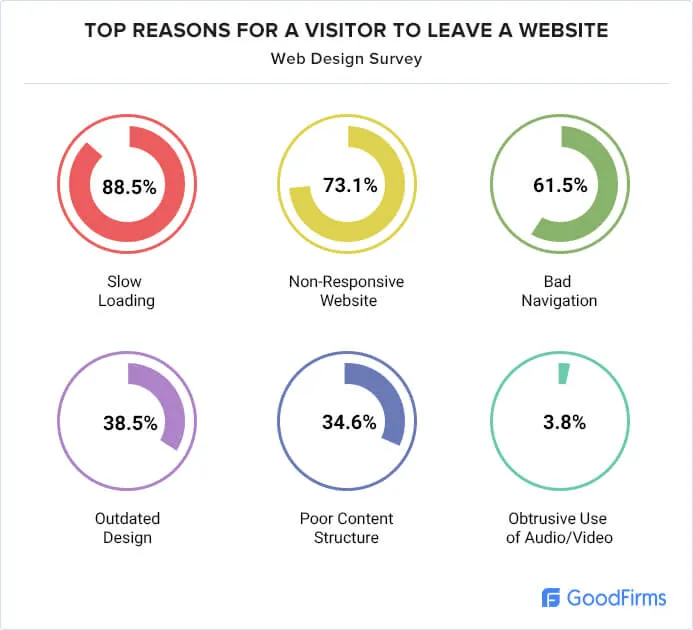Web Design for Small Businesses: Follow These 10 Simple Steps to Success
Good website design is crucial for brand growth, especially for small businesses that need to boost site traffic and sales. In fact, 80% of website credibility comes from design, and 94% of first impressions are design-related (WebFX).
The problem is, that website users are hard to please, with most bouncing off a webpage within 10-20 seconds if it doesn’t meet their expectations. How do you make sure visitors stay on your site and take action? These 10 steps will help you master small business web design and convert casual visitors into leads ready to engage.
Common Small Business Website Design Mistakes
Many small business websites struggle to get results due to common design mistakes. With over 1.13 billion websites globally, and only 200 million active, standing out is vital. Here are some mistakes that may be hindering your site’s success.

Source: GoodFirms
- Slow loading speed: Websites should load within two seconds to retain users.
- Lack of responsiveness: If your site doesn’t work well on mobile devices, users will leave.
- Confusing navigation: Visitors should easily find what they’re looking for.
- Cluttered content: Overloading with text, colors, or images overwhelms users.
- Autoplay videos/audio: Unsolicited media can frustrate visitors and cause them to exit.
If your website has these issues, it’s time to address them and optimize for a better user experience.
1. Conduct a Thorough Website Audit
A comprehensive website audit is key to identifying areas for improvement. This audit can reveal technical issues, outdated content, or poor site structure. Conduct these types of audits:
- Technical Audit: Check for crawl errors, broken links, and mobile optimization.
- SEO Audit: Identify opportunities for improving your search rankings.
- UX Audit: Analyze visitor behavior to improve navigation and design.
Professional web design services for small businesses can help you perform a detailed audit and implement changes for better performance.
2. Develop a Solid Brand Strategy
Use insights from your website audit to refine your brand strategy. Consistent branding across your site creates trust and recognition, which are key for conversions. Make sure your brand strategy includes:
- A clear mission statement
- Defined brand values
- A strong visual identity (colors, typography, and logo)
- Compelling messaging
3. Declutter Your Website
Clutter overwhelms visitors and detracts from your brand message. Keep your website simple by:
- Using white space effectively
- Keeping text concise and using bullet points
- Sticking to a limited color palette
- Using high-quality, relevant images
Consider professional website design services to overhaul and optimize your site for a clean, modern appearance.
4. Improve Search Engine Optimization (SEO)
SEO is crucial for small business websites. Optimized SEO practices help improve your visibility in search engines, which drives more traffic. Focus on:
- Using relevant keywords in titles, descriptions, and content
- Building backlinks from reputable sites
- Creating high-quality content that answers user queries
Tracking performance with tools like Google Search Console and Analytics will also help refine your strategy.
5. Simplify Navigation
Organize your navigation so that visitors can easily find what they need. Some tips:
- Use a hamburger menu on mobile devices
- Utilize drop-down menus for subcategories
- Add breadcrumbs to improve site exploration
- Include a search bar for faster navigation
Streamlined navigation enhances user experience and keeps visitors engaged longer.
6. Include Clear Calls-to-Action (CTAs)
Multiple CTAs guide users toward specific actions, such as signing up or making a purchase. Ensure your CTAs:
- Use strong action-oriented language
- Stand out visually (e.g., with a contrasting color)
- Are placed strategically throughout your site
Experiment with different CTAs to see which performs best.
7. Make Your Website Mobile-Friendly
The average eCommerce conversion rate on mobile is 3% (Dynamic Yield), and mobile acquired the highest percentage of returning visitors, at 74%. With mobile accounting for 74% of returning website visitors, your site must be mobile-responsive. Use a design that adapts to different screen sizes, providing an optimal user experience on all devices.
8. Incorporate Social Proof
Social proof builds trust. Add customer testimonials, case studies, and reviews to your site. Other ways to leverage social proof:
- Share positive feedback on social media
- Collaborate with industry influencers
- Include user-generated content, such as product reviews
9. Improve Site Speed
Slow sites lead to high bounce rates. Improve your website speed by:
- Compressing images and videos
- Reducing the use of non-essential plugins
- Using a Content Delivery Network (CDN)
- Enabling browser caching
Faster websites improve user satisfaction and increase conversions.
10. Place Contact Details Above the Fold
Make it easy for potential customers to contact you by placing your phone number, email, and CTAs above the fold. This ensures that visitors see the essential information immediately without having to scroll.
Boost Site Conversions and Sales: Hire Web Designers From Creative Nose Digital
Mastering web design for small businesses doesn’t have to be complicated. By following these 10 steps, you can create a user-friendly, visually appealing, and high-converting website. If you need expert help, consider Creative Nose Digital’s web design services to help take your site to the next level.
Contact Creative Nose Digital today to craft a website that delivers lasting results and positions your business for success.